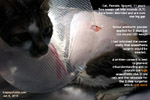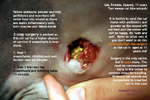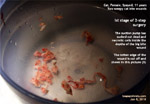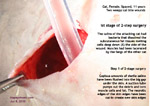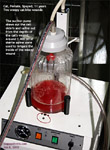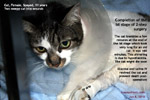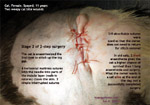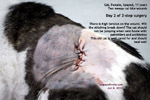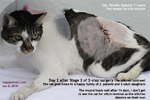An 11-year-old female spayed cat came in with two puncture wounds on her left flank. The wounds would not heal because they erupted a light brownish red fluid every day. Just like an active volcano.
Yet this cat was not feverish. The two wounds in the skin were around 4 mm x 4 mm. But they just would not close as they keep producing a reddish-brown liquid everyday.
"The bite wounds are not superficial on the skin only," I said to the father and two adult daughters. "I would need the cat to be put under the anaesthetic and explore the inside of the skin for debris. Therefore the cat must be warded for treatment and observation."
I gave the old cat an antibiotic and the tolfedine painkiller injection and put her in the crate for one day of observation.
On the morning of Day 2, I noted that the wounds were still weepy. My assistant Mr Saw had sprinkled his favourite yellow antibiotic powder onto the two wounds after cleaning up yesterday. Yet, the wound wept and all his yellow powder would spill out and downwards into the lower body of the cat. This cat's subcutaneous fat had been melted away by the bacteria introduced by the attacking cat's saliva and so there was abundant patch of loose skin around the puncture wounds exposing torn muscles. The jagged muscle edges were involved in producing the brownish red fluid that prevents the wound from closing well.
"Just flush the
inside of the skin with a 20-ml syringe," my first
assistant. Thomas replied when I asked him how
this case ought to be handled.
"You know, the suction pump is perfect for this case,"
I said. Thomas had never seen a suction pump despite
being used an assistant in over 10 years of assisting
in veterinary surgery with various employer vets. The
suction pump is rarely used but is useful in certain
conditions like peritonitis after surgery and maybe
after Caesarean sections.
"No need to use this suction pump," Thomas asserted.
"Just flush normal saline using a 20-ml syringe,"
Thomas replied. The suction pump was a piece of fancy
equipment to pragmatic Thomas. I decided to use the
pump.
TWO-STAGE SURGERIES AND TWO ANAESTHESIAS
All old cats are high anaesthetic risks. This cat was
thin but she looked very young. She just did not have
a large appetite normally and weighed 3.3 kg when a
good weight for her would be 5 kg. There would be 2
stages of Surgery and two anaesthesias needed for two
surgeries and the owner must be informed in advance as
to the costs, to avoid misunderstanding.
The first stage would be to debride and flush out the
dead muscle and fat cells. Then, on the next day, at
the second stage, the cat would be anaesthesized to
stitch up the debrided skin edges wounds. There was no
other way and so the risks of the cat dying on the
operating table would be doubled. Definitely, the
owner should be asked to sign the surgery consent form
and receive advices on the prognosis and the costs. It
would be costly to treat this case. After all, it was
simply just a cat's being bitten. What is so difficult
about treating this case. Just an injection and some
antibiotics and cream to go home. This would be what
some vets would do. But the clinical outcome would be
unsatisfactory for the owner.
FIRST ANAESTHESIA.
Zoletil 100 @ 0.2 ml IV femoral vein was given.
Isoflurane gas via the mask was given to supplement as
over 30 minutes were needed. I needed to cut away dead
skin and muscle cells from damaged layers. Thomas
said: "The muscle layers inside need to be stitched
up, otherwise the cat would continue to have fluid
production. When stitched, there would be no problem."
It is always good to get suggestions from assistants
but the vet must know what to do.
I said: "This is a very old cat. Healing of the wound
will be slow. To stitch up the torn flank muscles, I
would need to cut a bigger skin incision to reach deep
into the muscles layer near the belly. If the big
wound does not heal, the cat would be in trouble
having a large skin defect. If this is a young cat, it
will be OK."
I observe that the cat could walk normally and so I
would not advocate stitching of the irregular torn
flank muscles. In old cats and dogs, it is best not to
create big skin incisions. About 1000 ml of normal
saline were squirted into the big space between the
skin and the left flank muscles. A big suction tube
pulled out yellowish fat and dead cells. I used
scissors to snip off jagged muscle edges.
After the suction was completed, I checked the cat
half an hour later. The cat was on an IV drip of
normal saline. She was shivering. "Take the rectal
temperature," I said to my intern Teresa. She put the
thermometer in the rectum and showed me 33.5 deg C.
This was low and worrying. Her normal temperature
should be 38.5. This old cat had not taken anaesthesia
and flushing well. Thomas blew hot air onto the cat
using the hair dryer and rubbed her with a towel.
"Give 20 ml of glucose," I said. This was given. The
cat was wrapped with a towel. 2 hours later, her
temperature was 36 deg. She growled as she did not
like temperature taking. By the next morning, her
temperature was normal. What was the cause of this
hypothermia? "Irrigation of the flank with normal
saline," Thomas said. This was plausible. I would
think it was more the after effects of Zoletil as
well.
SECOND ANAESTHESIA
24 hours after the flushing, there was no more weeping
wound. The flesh looked pink. I masked the cat and
gave isoflurane gas and she did not struggle.
Stitching was done using horizontal mattress sutures,
walk-in-sutures onto the muscle before stitching the
skin and 2 appositional sutures using 3/0 absorbable.
The cat woke up fast and had no shivering. She ate and
went home one day later.
CONCLUSION
Isoflurane gas would be the choice anaesthesia in old
dogs and cats. However, this cat was not very happy
with her puncture wounds being poked around. As I did
not want to stress her, I did not give her isoflurane
gas direct during the first anaesthesia. Zoletil was
sufficient for flushing of the flank. The process took
a long time as I wanted to be thorough. Next time,
flank irrigation could be shortened to 5 minutes
instead of 15 minutes after debridement for old cats
as they develop hypothermia easily.
In the usual cat bite wound cases, antibiotics and
cleaning of the wounds would be sufficient treatment.
In this case, the muscles were torn and infected deep
below the skin. That was why the two puncture wounds
produced a sero-sanguinous fluid daily and would not
close. My vet assistant poured antibiotic powder onto
the wounds as is the usual practice. The powder would
just lodge deeper into the lower abdominal
subcutaneous tissue and the wound just would weep
again. The only effective treatment was to flush out
the dead tissues rather than pour antibiotic powder so
that the wounds would heal within 14 days.
Veterinary Performance counts in private
practice. If the vet gives the owner a bottle of
antibiotic powder and medication expecting the wound
to heal, the owner would be much disappointed as such
wounds would never heal. The owner would have wasted
much time in putting powder clogging up the internal
loose cavities of subcutaneous tissue destroyed by the
bacteria toxins. In the end, the cat still needed
surgery and the owner ends up paying much more.
This was not the simple case of cat bite wounds and
the costs would be much higher as it involved two
anaesthesias and surgeries. However, the clinical
outcome was excellent. And that is what the owner
wants - her cat's problems resolved in the fastest
time.
 TOA
PAYOH VETS
TOA
PAYOH VETS
